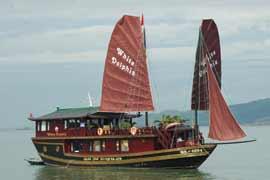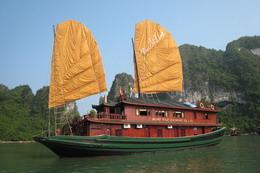|
The
Viet Nam Museum of Ethnology was established in Ha Noi in 1987 to preserve the
cultural heritage of the nation’s 54 ethnic groups. The facility is both a
research centre and a public museum with a mission to collect, document,
perserve and exhibit the cultural heritage of these different groups.
 | |
Cultural classic: Foreign tourists
visit the Viet Nam Museum of Ethnology, which celebrates the culture of the
nation’s 54 ethnic groups. | The museum has both
indoor and outdoor exhibitions. The indoor exhibitions are housed in a
two-storey building with architecture inspired by an ancient bronze drum. It
includes exhibition space, a research centre, a library, a laboratory and an
auditorium, as well as storage facilities
A granite bridge leads
from the main gate to the exhibition areas. The first floor is decorated with
dark tiles arranged in an S-shape that symbolises the shape of the Vietnamese
coastline.
The museum collection
includes thousands of artefacts, photographs, and audio and video documentation
of Vietnamese ethnic groups. Dioramas highlight certain customs or cultural
features of specific groups. Objects are labelled in English and French for
international visitors, who are able to learn about the displays without a
guide.
The objects displayed
in the museum reflect the everyday lives of the people, and the museum’s
consistent point-of-view is that the displays are simple, allowing visitors to
admire the beauty and finesse of these ordinary and simple items, including
knives, baskets, garments, mats and musical instruments. Photographs and video
installations are further used to illustrate the items in the context of
people’s lives.
 | |
Tomb tourists: Foreign visitors
look at a Gia Rai ethnic tomb at the Ethnology Museum. (Photos: VNS) | The museum has 54
collections dedicated to each individual ethnic group. The artefacts are further
classified functionally into collections of clothing, jewelry, agricultural and
fishing implements, household utensils, and musical instruments, and weaponry.
There are also collections of artefacts related to various religious beliefs and
ceremonies, and the museum has published a number of books and catalogues to
reflect these different interests.
People come to the museum not only
to learn about the cultural diversity and traditional values of each of the
country’s unique ethnic groups, but also to relax and be entertained. With fun
activities and regular performances of water puppetry or ca tru (ceremonial
singing), the museum is a great place for children.
Ngo Hoai Nam from Ha
Noi says he often brings his kids to the museum on weekends and holidays.
“It is not just a
museum to store old things,” Nam said. “When we come here, my children can learn
about traditional culture, make traditional toys, and play folk games like clay
banger, tug-of-war and leapfrog which are not easy to find in other places.”
 | |
No strings: Visitors to the museum
can watch water puppet performances. | Visitors may bring a
picnic lunch and enjoy the grass by a small stream, or eat at the museum
restaurant before relaxing outdoors. The outdoor exhibition area focuses on the
different types of traditional houses around the country, including an E De long
house, Tay and Dao stilt-houses, a wooden Hmong house, and a traditional
tile-roofed Vietnamese house, as well as a Gia Rai tomb. A Ba Na communal house
and Cham and Ha Nhi houses are the latest additions.
Beside the houses are
trees indigenous to the area of each house, all linked by zigzagging paths and a
meandering stream crossed by small bridges.
A tourist from the US
city of Boston, who doesn’t show his name, visits the museum with a two-year-old
child and says, “The historic houses are incredibly varied and interesting,
although climbing up and down those teeny ladders is not for the faint of heart
or poor of balance.”
After catching a water
puppetry performance on a Sunday afternoon, he said, “I would rate this an
absolute must-see for families with young children. Highly recommended.”
The Museum of
Ethnology is located at Nguyen Van Huyen Street, Cau Giay District, about 8km
from Ha Noi’s centre. It opens everyday except Mondays from 8.30am to 17.30pm.
In the future, the
museum will expand its mission to the cultures and civilisations of other
neighbouring countries Southeast Asia, all to be displayed in a new building
built in the shape of a kite.
Construction of the
“Kite” building of Southeast Asian cultures began since 2007, according to Vo
Quang Trong, the museum’s director.
On its three floors,
there will be space for permanent and temporary exhibitions, object conservation
and restoration, educational activities, conferences, and multimedia to
introduce Southeast Asian cultures, he says.
“The new museum aims
to help the visitors understand the link between Viet Nam and the Southeast Asia
in a regional culture of unity and diversity,” Trong says, “it also shows the
responsibility of Viet Nam, an ASEAN member, in disseminating and preserving
regional identity.”
Every year the museum
receives hundreds of thousands of visitors.
VietNamNet/Viet
Nam News | 














